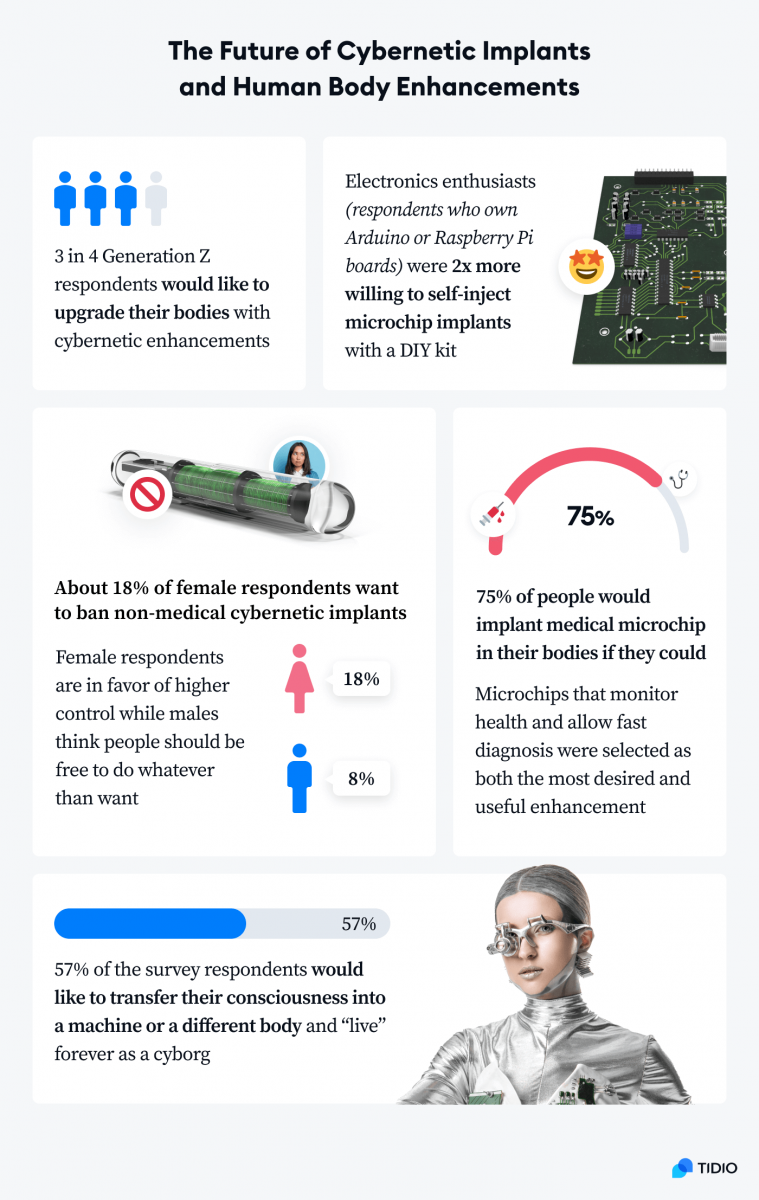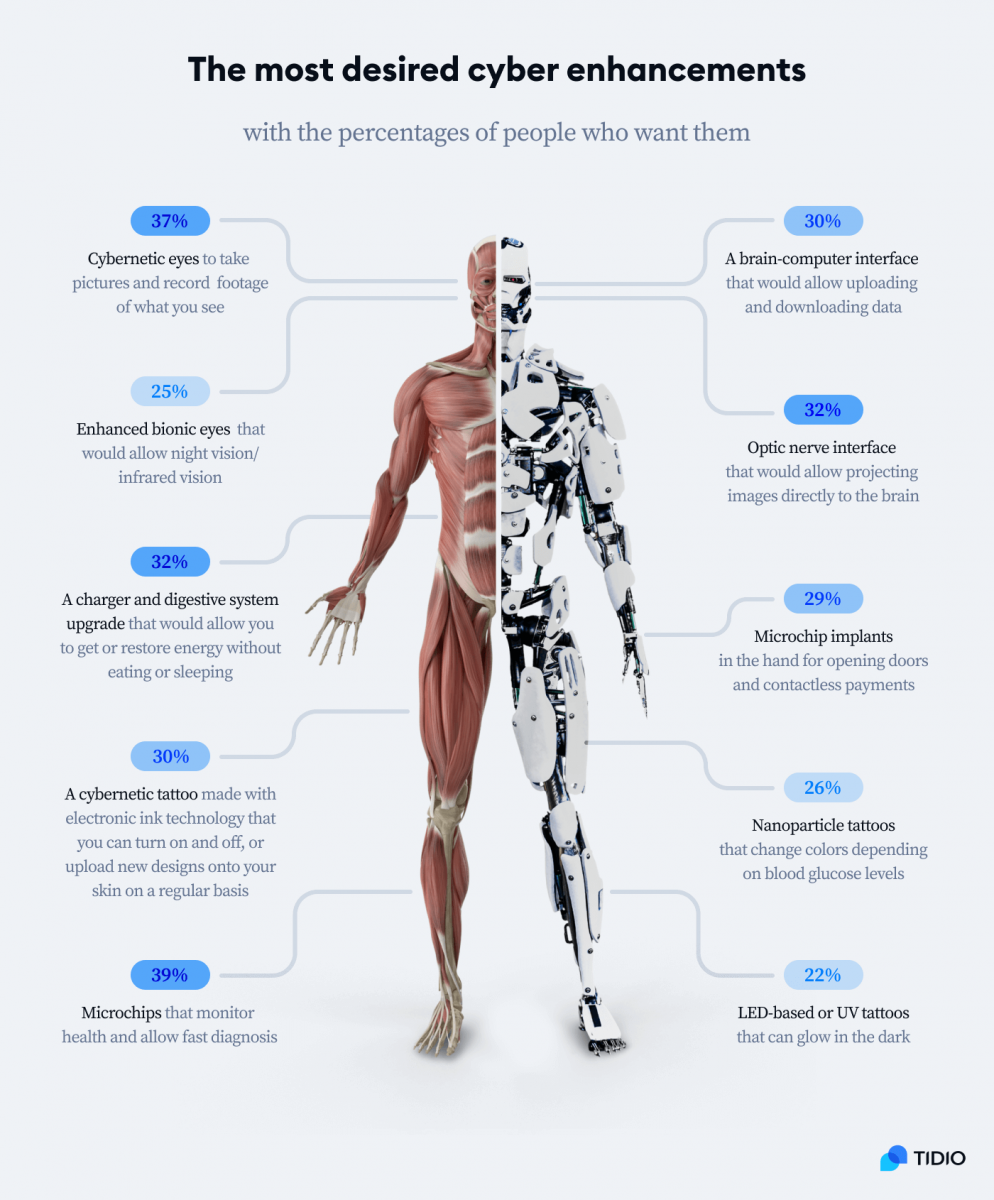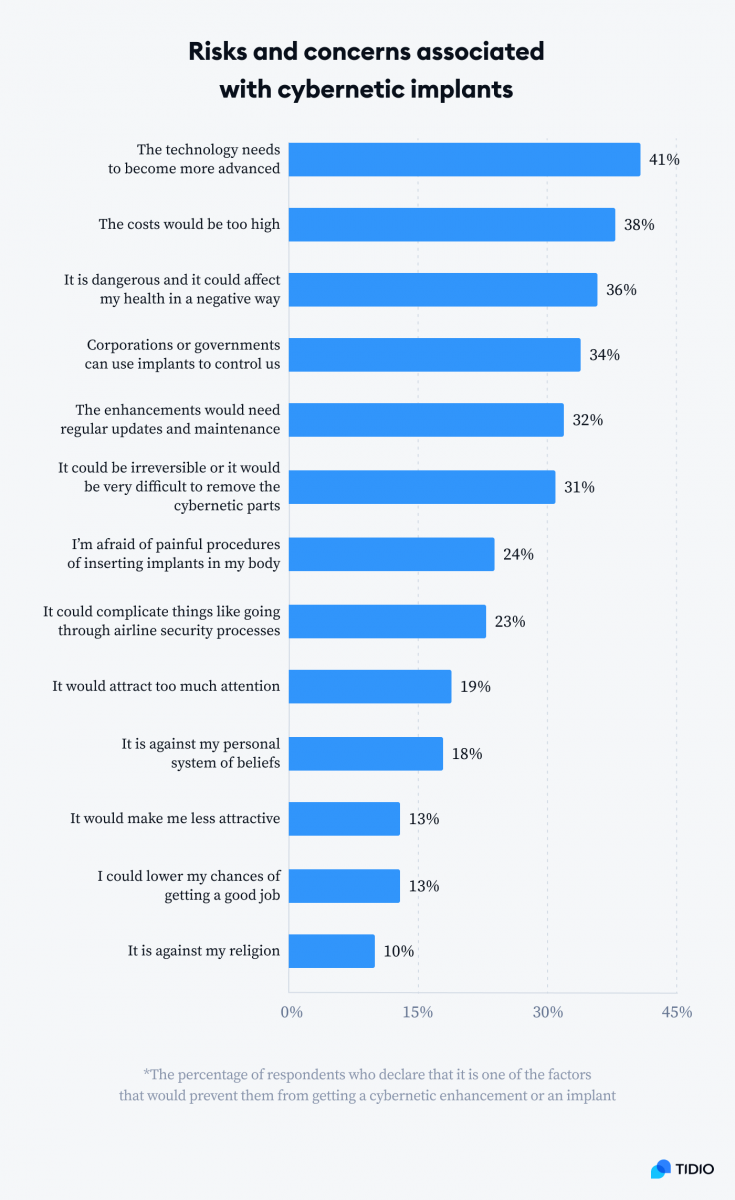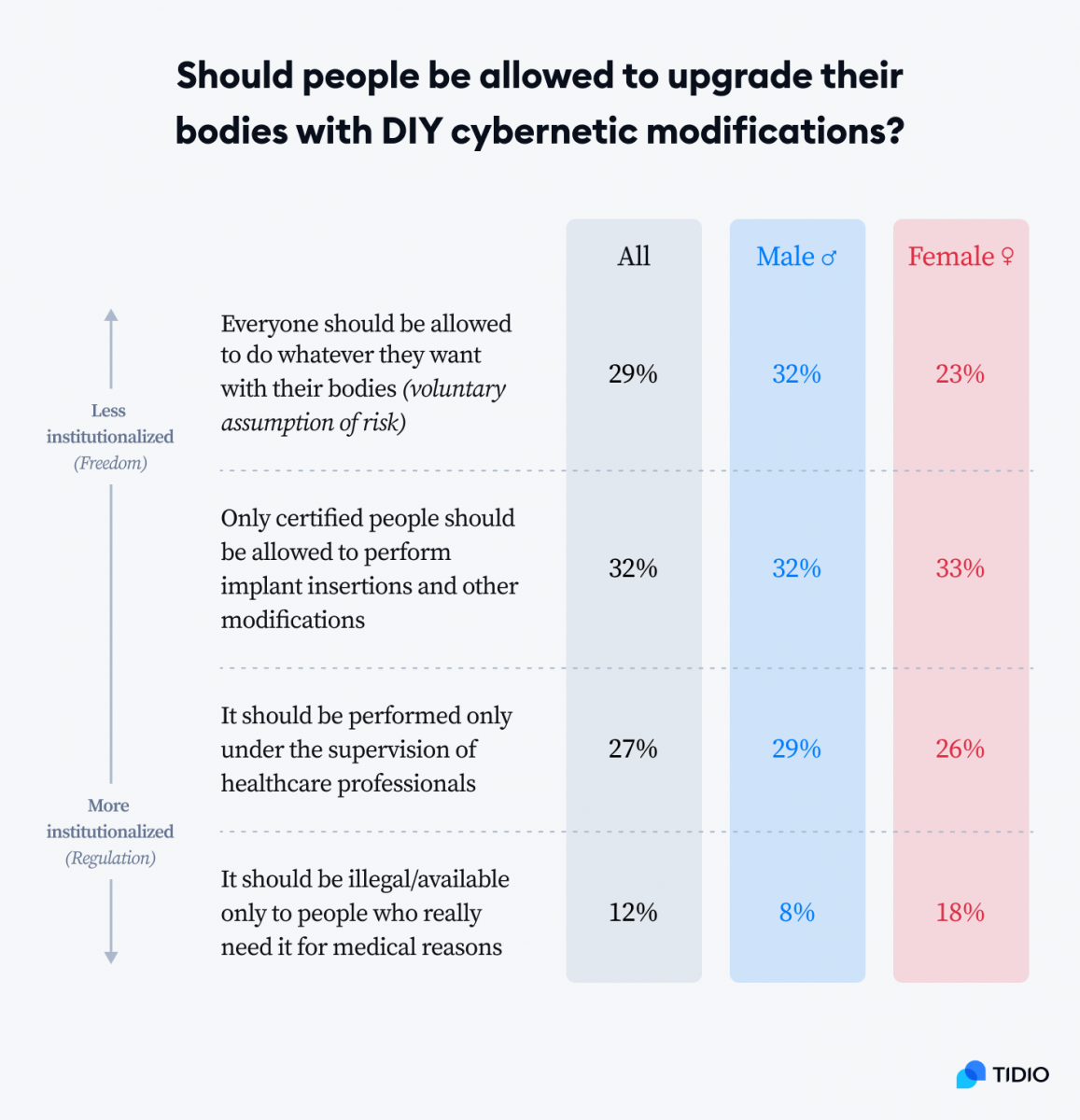For most of us, cybernetic implants still seem like something straight out of a science fiction movie. Yet, more and more people are deciding to have RFID microchips or biomagnets implanted in their hands and fingers.
There could already be over 100,000 people who “biohacked” their bodies. Just one microchip retailer based in Seattle has partnerships with more than 100 biohackers and body modification specialists all over the world. Chances are you can get a cybernetic implant in your city—if you know where to look
We decided to examine this trend and find out the answers to the following questions:
- What are the most desired body upgrades?
- Are people ready to adopt this technology?
- Are cybernetic enhancements the next step in human evolution?
If you are interested in AI technology, you may also be interested in our other reports:
- Will AI Take Your Job? AI Trends for 2021
- Can We Distinguish AI-Generated People and Real Photos?
- AI in Education: Will Tech Destroy Education?
Now—
We’ve surveyed 1,127 respondents and here are some of our most interesting discoveries.
Major findings: Cybernetic implants and body upgrades
Some people think that cybernetic “upgrades” are just a craze.
Grinders, cybergoths, and biohackers are perceived as just another subculture that wants to shock the general public.
Cybernetic enhancement is the use of cybernetics and technology to improve the functioning and performance of the human body. The concept is still mostly theoretical but prosthetic limbs, microchip implants, and computer-brain interfaces may become widely available in the future.
For the moment, the use of implants is limited and they can be seen simply as a type of body modification. Some, however, believe that cybernetic enhancements will make us smarter, faster, or even immortal.
More than 75% of people are willing to implant a microchip to monitor their health
Health monitoring is one of the most promising applications of cybernetic implants. Three in four respondents would allow such implants in their bodies. Such devices would enable more accurate and faster diagnosis. Interestingly, research on microchip implants in healthcare is at a fairly advanced stage.
About 56% of respondents believe that cybernetic implants will become a widespread technology during the second half of this century
Over half of the survey respondents think that cybernetic enhancements will become as commonplace as smartphones after the year 2050. Only 12% think that they will become popular within the next decade. About 11% believe that this technology will never become widely available.
As many as 74% of Generation Z respondents like the idea of upgrading their bodies with cybernetic enhancements
The same is true for only 64% of Millenials and about 55% of older respondents. While the majority still finds this technology too primitive, the youngest segment is very open to various possibilities offered by the development of cybernetic solutions and body upgrades.
Arduino or Raspberry Pi users are twice more willing to self-inject microchips with DIY cyber enhancement kits than those who don’t own any of the boards
Almost 70% of Raspberry Pi/Arduino owners declare they would inject a microchip implant on their own with a DIY kit if they were widely available. Among the respondents who don’t have them, only 35% would do the same.

According to 42% of the survey respondents, cybernetic enhancements should only be available to restore body functions lost in accidents or due to diseases
Opinions are very divided, and for every person who favors free access to implants and body enhancements (51% of respondents), there is someone who believes that access should be restricted (42%) or that cybernetic implant research should be banned altogether (about 6% of respondents).
Almost 63% of the youngest respondents think cybernetic implants will become trendy because of the “cool” factor
Gen Z respondents believe that implants can be cool and trendy. Furthermore, 71% of them believe that cybernetic enhancements can be an expression of who you are—just like piercing, tattoos, and other body modifications.
Almost 55% of Millennials think that the risks associated with cybernetic implants outweigh their potential benefits (but Gen Z respondents aren’t so sure)
Generation Z seems to believe that the potential benefits linked with cybernetic enhancements and microchips are very promising. Only 35% of them think that risks outweigh the benefits, which is the lowest result among all age groups.
About 65% of tattoo owners and respondents with piercings say they would allow their (hypothetical) teenage child to implant a bionic eye
Body modification enthusiasts claim to be more liberal towards accepting choices of their potential offspring. If their teenage child wanted to replace a perfectly healthy eye with a bionic eye to play virtual reality video games, only 35% would object. For those without tattoos or piercings, the numbers are reversed.
Ten best cybernetic body enhancements
Quite recently, a boy genius with a degree in physics has announced that he wanted to achieve technological immortality.
How?
I want to be able to replace as many body parts as possible with mechanical parts. I’ve mapped out a path to get there. You can see it as a big puzzle.

By replacing body organs with robotic parts people will be able to extend their lifespan. But there are some discrepancies between the most useful enhancements, the most desired ones, and the ones that are actually installed as of 2021.

The most desired cyber enhancements (with the percentages of people who want them):
- Microchips that monitor health and allow fast diagnosis (39%)
- Cybernetic eyes to take pictures and record footage of what you see (37%)
- Optic nerve interface that would allow projecting images directly to the brain (32%)
- A charger and digestive system upgrade that would allow you to get or restore energy without eating or sleeping (32%)
- A cybernetic tattoo made with electronic ink technology that you can turn on and off, or upload new designs onto your skin on a regular basis (30%)
- A brain-computer interface that would allow uploading and downloading data (30%)
- Microchip implants in a hand for opening doors and contactless payments (29%)
- Nanoparticle tattoos that change colors depending on blood glucose levels (26%)
- Enhanced bionic eyes that would allow night vision/infrared vision (25%)
- LED-based or UV tattoos that can glow in the dark (22%)
When asked about cybernetic enhancements with the biggest potential to help a lot of people, the survey respondents chose slightly different options. They prioritized prostheses and other upgrades with strictly medical functions.
The most useful technologies with real-world applications:
- Microchips that monitor health and allow fast diagnosis (44%)
- Prosthetic arms (40%)
- Bionic legs (38%)
- A brain-computer interface that would allow uploading and downloading data (32%)
- A charger and digestive system upgrade that would allow you to get or restore energy without eating or sleeping (30%)
It is worth noticing that medical microchips for monitoring health and fast diagnosis are both the most sought after and perceived as useful. Given the positive attitude toward this type of implant, the wide range of its applications, it is the most promising of the technologies discussed in this article.
Cochlear implants, which are advanced hearing aid devices, are already worn by over 750,000 people worldwide. But even the simplest microchips, like basic RFID implants, could revolutionize healthcare as we know it.
Being chipped will allow paramedics and hospitals to identify you and get information about medical conditions even if you are unconscious. To me, it’s amazing that if a runaway horse gets hit by a car in Sweden, the police can immediately scan its chip and know it’s Bessie and it belongs to Mr. Andersson at such and such address, but a human without a wallet is unidentifiable.

Medical microchips seem to go hand in hand with the development of biosensors and other biotech devices. More advanced microchip implants could become the future of healthcare sooner than we’d expect.
The idea of scanning patients rather than guessing what’s wrong with them through medical interviews and traditional examinations sounds very appealing. About 51% of our respondents declare that they will get a microchip implant once they become more popular.
The least desired enhancements and body modifications:
- Cosmetic surgeries that can turn your face into that of anthropomorphic animals, for example, a wolf or a cat (9%)
- Magnets inside fingertips to sense electronic devices (17%)
- A pleasure implant that brings euphoria at the push of a button (18%)
Incidentally, magnetic implants, pleasure-inducing implants, and extreme cosmetic modifications are relatively available. Implanting magnets to “feel” electrical signals is a popular body modification and the procedure is quite safe. Electromagnetic waves or sound can be experienced without state-of-the-art neural implants. But creating a two-way connection between mechanical and electrical parts and our nervous system is the biggest challenge right now.
Right now, Elon Musk’s Neuralink is trying to develop implantable brain-machine interfaces. But when exactly will Neuralink be tested on humans? According to some recent announcements, the devices will be tested on humans by the end of 2021. For the moment, we have to settle for monkeys playing Pong. The joysticks are disconnected but the paddles still move across the screen, controlled by brain implants.
Potential issues with cybernetic body modifications and microchip implants
People are currently hesitant about microchips because the technology is believed to be still too immature. About 69% of the respondents who took part in our study believe that right now the cybernetic enhancement technology is too primitive. About 41% singled this factor out as their primary concern that would prevent them from upgrading their body with cybernetic implants.

Interestingly, the very same things that our survey respondents identified as potential problems could also be promising solutions that will increase our comfort. It all depends on the level of adoption of the technology.
The big one for me is passport control. If I had a chip which confirmed my identity and could go in a separate line, it would be brilliant.

A small fraction of the survey respondents identified themselves as cyberpunks, hackers, biohackers, and transhumanists or felt close to the values held by these movements and subcultures.
About 51% of all respondents believed, however, that cybernetic enhancements should be available for everyone who wants them without limits.

Female respondents were in favor of a higher level of regulation. In fact, they were twice as willing as men to make DIY cybernetic enhancements illegal (18% of female vs 8% of male respondents).
Some of our survey respondents were also concerned about military applications of cybernetic human enhancements. About 63% will be used by the military to create super-soldiers
DARPA ( Defense Advanced Research Projects Agency) has been working on exoskeletons and military robots for quite a while. But will the “Borg” army take over the world? That’s highly unlikely. Although we have to admit that Jeff Bezos controlling a giant robot in real-time is the stuff of nightmares.

Are we ready for the future of cyborg superhumans and technological immortality?
Today, cyborg activists who advocate the idea of transhumanism, such as Neil Harbisson, may make you smirk. They look like beings from a cyberpunk movie but many see them as attention-seeking TV/Internet personalities who are “futuristic” and weird just for the sake of being weird. However, the advancement of cybernetic enhancements may soon accelerate. Our notions of what a human being or human body is can be challenged within the next few decades.
A growing number of people are opening up to the possibilities offered by body implants, wearable electronics, or nanotechnology. Once the majority of them become practical rather than aesthetical body enhancements, we will start to navigate through the uncharted territory of the development of the human species. While sci-fi movies and literature appear to provide a template for our future, reality always turns out to be weirder than fiction.
Sources:
- A Practical Guide to Microchip Implants
- Microchips in Medicine: Current and Future Applications
- Why It’s Not Possible for the COVID Vaccines to Contain a Magnetic Tracking Chip That Connects to 5G
- I Am Microchipped and Have No Regrets
- 11-Year-Old Gets Physics Degree, Says He’ll Use It to Attain Technological Immortality
- 8 Bold Biohacks That Blur the Line Between Human and Machine
- This Company Will Help You Become a Cyborg, One Implanted Sense at a Time
- Will Today’s Newborns Become Immortal Cyborgs?
- People Plus: Is Transhumanism the Next Stage in Our Evolution?
- ‘Body Hacking’ Movement Rises Ahead Of Moral Answers
- Is This the Future of Robotic Legs?
Methodology:
For this study about microchip implants and cybernetic body upgrades, we collected answers from 1,127 respondents. We used Amazon’s Mechanical Turk and Reddit.
Respondents were 57% males and 42% females. The sample’s average age was 37 with a standard deviation of 13. Considering such age and gender makeup, the study’s findings could be extrapolated to the general US population.
Respondents had to answer about 20 questions—the majority of which were scale-based or multiple choice. The survey had an attention check question.
Fair Use Statement:
Has our research helped you learn more about cybernetic enhancements? Feel free to share statistics from this study. Just remember to mention the source and include a link to this page. Thank you!

